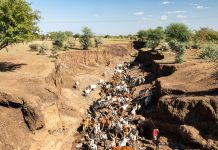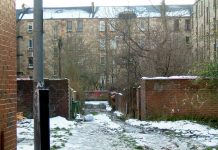Amy G, a seismologist, argues that poverty and inequality must be tackled to reduce the suffering caused by earthquakes.

Almost 3800 people are reported dead and over 7000 injured from the magnitude 7.8 earthquake in Nepal on Saturday. This number is expected to rise in the coming days. Aftershocks, including a magnitude 6.8 on Sunday, have caused further damage. In towns and villages near to the epicentre, and in the capital Kathmandu, buildings have been reduced to rubble, trapping people beneath them. Hospitals are struggling to cope with the numbers of injured people. The earthquake also triggered avalanches on Everest, killing 17 mountaineers. Landslides caused by the earthquake are now making it even more difficult to access remote villages.
The earthquake occurred on the Main Frontal Thrust in the Himalayas, a fault that is part of the boundary between the tectonic plates of India and Eurasia. It is an area where we have historical evidence of large earthquakes having happened, such as the 1934 Nepal-Bihar earthquake that occurred around 240km southeast of Saturday’s quake.
Nepal is one of the poorest countries in Asia. The urban population has grown massively in the last 20 years: the population of Kathmandu has more than doubled. Many of those who have moved to the city live in poorly constructed housing, which has been unable to withstand an earthquake of this size.
The size of an earthquake, the depth of an earthquake, and the geology of the area where an earthquake happens, will all play a role in determining the damage that occurs. These are things we can’t control.
But just as crucial in determining how many people might be killed and injured are things that we can control and are mainly determined by poverty: can buildings withstand an earthquake, do people know what to do if an earthquake does happen, can the infrastructure of a region cope if an earthquake happens. These are all things where the economic resources of a country are a key, where the number of people killed by what might be very similar event seismically, can be hugely different. Millions of people globally live on top of faults that have the potential to cause devastation, but the reality is that the impact of earthquakes in these places is not the same. In relatively rich places like California or Japan far fewer people will die directly as a result of an earthquake compared to places where people are poor like Nepal or Haiti.
We can’t predict earthquakes. We’re not going to when and where exactly a fault will break, but we can prepare for them, and try to mitigate the effects when they do occur.
This means ensuring that there are resources available in earthquake-prone regions to make sure that buildings meet the standards needed to withstand earthquakes. It means continuing with earthquake preparedness drills. It means ensuring that when an earthquake does occur there are the resources to help those who are trapped, injured, homeless and who have lost loved ones. It means having the resources to cope with landslides and tsunamis an earthquake might trigger. It means funding scientific research into what the effects of earthquakes to find out thing like if there are seismogenic faults we don’t know about, how will the waves from an earthquake propagate through the Earth, what is the state of stress of different parts of a fault system. It also means tackling the causes of inequality and poverty that are at the heart of so many death and suffering resulting from earthquakes.




















